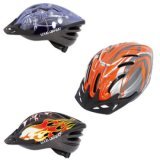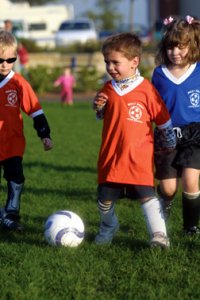The 7 Most Dangerous Youth Sports in America
by www.SixWise.com
The benefits of sports for children are seemingly limitless. They
can build character, self-esteem and social relationships, instill
a sense of belonging and team building concepts, be a venue for
social development-not to mention the positive effects that activity
has on a child physically.
But as with so many things in life, with the benefits comes the
potential risk for injury. According to the National Safe Kids Campaign,
some 20 percent of children participating in sports activities are
injured-and one out of four of these injuries is considered serious.
Knowing how to reduce your child's risk of injury is the first
step to ensuring that he or she has a positive sports experience,
which is why SixWise.com has compiled a list of tips to keep your
children safe while they play.
Based on information from the Consumer Product Safety Commission
(CPSC) and an ESPN sports poll published in the Sports Business
Journal, here is a general risk of injury from seven of the top
sports in America.
Risk of Injury in Seven Top U.S. Youth Sports
| Sport |
Percentage of injuries vs. total participation |
| 1. Football |
13.8% |
| 2. Mountain biking |
7.7% |
| 3. Basketball |
6.0% |
| 4. Soccer |
3.5% |
| 5. Skateboarding |
2.7% |
| 6. Baseball |
2.6% |
| 7. Softball |
2.3% |
Football
Wearing protective equipment is one of the more important ways
to minimize the risk of injury. Necessary equipment that is, fortunately,
required by most youth football leagues includes:
- Helmet
- Shoulder pads, hip pads, tail pads, knee pads
- Pants (one piece or shell)
- Thigh guards
- Jersey
- Mouthguard with a keeper strap is require
- Athletic supporter
- Proper shoes (individual leagues have varying requirements,
so check with the coach for details)
- If eyeglasses are worn, they should be made of non-shattering
glass
Mountain Biking (and other bicycling)
According to the National Head Injury Foundation, each year nearly
50,000 bicyclists suffer serious head injuries leaving them with
permanent disabilities.
The good news is that helmets can greatly reduce this risk. A study
in Seattle found that wearing a bicycle helmet reduced the risk
of head injury by 85 percent. Other biking risks include:
- Collision with a car or another bicycle
- Loss of control
- Mechanical and structural problems
- Getting hands, feet or clothing tangled in the bike
- Feet slipping from the pedals
In regard to bike helmets, which should be worn EVERY time your
child-or you!-rides a bike, the helmet should:
- Sit level and firmly on your child's head, but not be so tight
that it's uncomfortable.
- Not be tilted forward or backward.
- Not be worn over a baseball hat.
- Have strong, wide straps that fasten snugly under the chin (you
shouldn't be able to fit more than a finger under the strap if
it's on properly).
- Always be fastened while riding.
- Be replaced after a serious fall, as helmets lose their capacity
to absorb shock after taking a hit.
 Louis
Garneau Grunge Kids Helmets look so cool that your kids
will be begging to wear them. Just don't tell them about all
the added safety features like the: Louis
Garneau Grunge Kids Helmets look so cool that your kids
will be begging to wear them. Just don't tell them about all
the added safety features like the:
- Quick-release buckle fastener with ergonomic shape.
- Airdry Fusion that provides better comfort and ventilation.
Helmet stabilizing device for integrated receptacle.
- Rack-and-pinion mechanism for tight and quick adjustment.
Airdry padding for optimum comfort.
- (For ages 6 to 15)
|
If you have a hard time getting your older child or teen to wear
a helmet-you're sure that he takes it off as soon as he gets down
the block-Amazon.com has some Louis
Garneau Grunge Kids Helmets that look so cool your kids will
be asking for one in each color!
Basketball
Sprains and strains to the ankle and knee are the most injuries
in basketball. Some 38 percent of boys and 36 percent of girls playing
basketball have had an injury to their ankle or foot.
According to a study by the National Athletic Trainers Association
(NATA), the most common causes of injuries in basketball result
from:
- Scrambling for loose balls (34.4% boys; 36.3% girls)
- Controlled pattern activity (27.7% boys; 32.6% girls)
- Rebounding (26.0% boys; 30.8% girls)
To reduce the risk of sprains and strains, the American Academy
of Orthopaedic Surgeons recommends that athletes:
- Follow a pre-season conditioning program to build muscle strength.
- Warm up before the sports activity, including practice.
- Listen to their bodies and never run if he or she experiences
pain in the foot or ankle.
- Replace athletic shoes when they are worn out.
- Always wear properly fitted shoes that are tightly laced. Loose-fitting
shoes allow the foot to twist from side to side.
Soccer
|

Shin guards are extremely important for young soccer players.
Soccer tournament records show that most players who suffered
from lower leg injuries were not protected adequately by shin
guards.
|
The following tips can help to prevent soccer injuries, according
to the American Academy of Orthopaedic Surgeons:
- Cold muscles are more prone to injury, so always take time to
warm up and stretch.
- Wear shin guards to help protect your lower legs. Soccer tournament
records have shown that most players who suffered lower leg injuries
were not adequately protected by shin guards.
- Wear shoes with molded cleats or ribbed soles. Shoes with screw-in
cleats often are associated with a higher risk of injury. However,
shoes with screw-in cleats should be worn when more traction is
needed, such as on a wet field with high grass.
- Synthetic, nonabsorbent balls should be used on wet playing
fields, as leather balls can become water-logged and very heavy
when wet, putting players at high risk for injury.
- Goals should be well padded and secured to reduce the risk of
head injuries if players collide with the posts.
- Injuries and deaths have occurred when goals have fallen onto
players, so don't climb on or sit on goals.
Skateboarding
Since skateboarding involves moving quickly over hard surfaces,
it can result in injuries ranging from minor cuts and bruises to
serious brain injury. Many injuries involve the wrist, ankle or
face and result when a person loses their balance or control and
falls.
To reduce the risk of injury, proper equipment must be worn, which
includes:
- A properly fitting helmet
- Wrist guards
- Knee and elbow pads
- Proper shoes
Other tips include:
- Use a high-quality skateboard
- Keep your skateboard in good condition
- Learn the basic skills of skateboarding
Baseball and Softball
According to a NATA study, the most common injuries suffered by
baseball players are:
- Scrapes, bruises, muscle cramps/spasms
- Strains
- Sprains
- Fractures
To protect your young baseball or softball player, make sure that
he or she:
- Wears appropriate safety gear
- Helmets
- Eye protectors
- Shoes with molded cleats
- Additional safety gear for catchers
- Limits pitching time and takes required rest periods if pitching
- Warms up before playing
- Does not keep playing if in pain
- Listens to coaches safe playing advice, such as not allowing
headfirst sliding for young players and dodging a ball pitched
directly at him or her
And for all sports, make sure to keep the focus on fun! Too much
pressure to win can push children too hard and increase the chances
that they could get hurt.
Sources
Momsteam.com
Sportime
American
Academy of Orthopaedic Surgeons